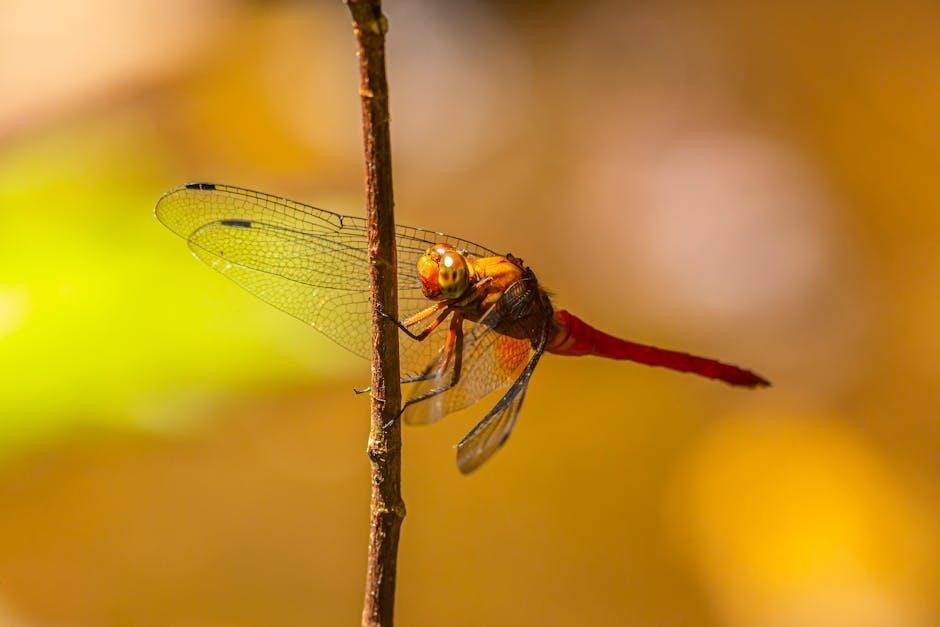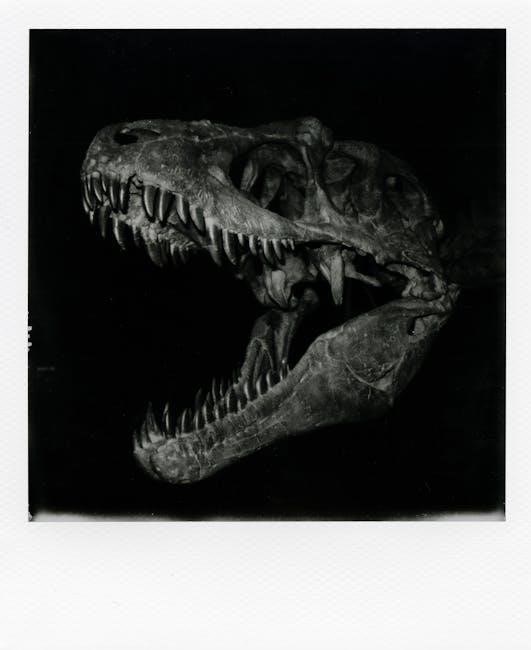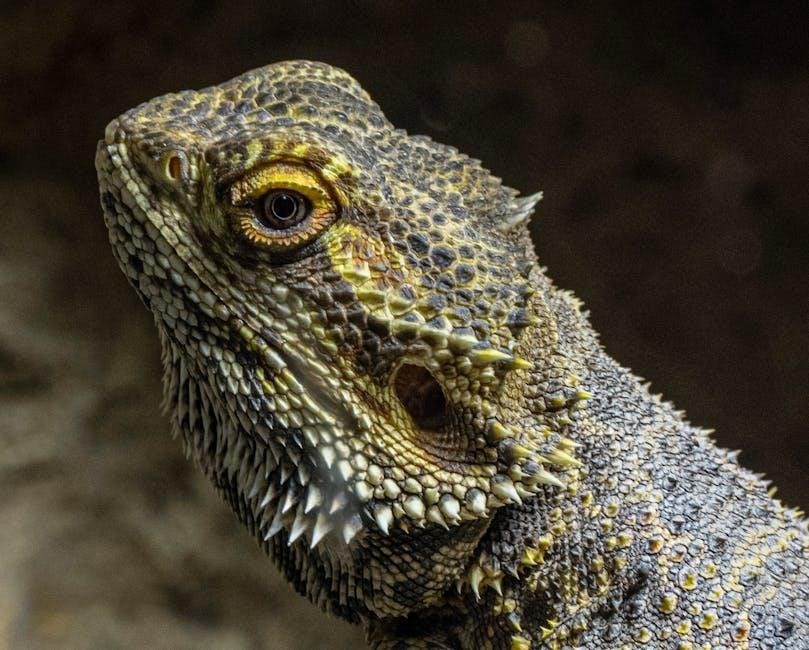Evolution is the scientifically supported theory explaining how species change over time through genetic variation and environmental pressures. It underpins biology, helping us understand life’s diversity and adaptation mechanisms.
1.1 Definition of Evolution
Evolution defines the gradual change in species over time through genetic variation and natural selection. It explains how life adapts to environments, resulting in biodiversity. This process is supported by evidence like fossils, comparative anatomy, and biogeography, illustrating how species descend with modifications.
1.2 Importance of Studying Evolution
Studying evolution is crucial for understanding biodiversity and how species adapt over time. It informs fields like medicine, agriculture, and conservation, addressing societal challenges. Evolution provides a foundation for biology, guiding research and fostering a deeper appreciation of life’s complexity and interconnectedness.
1.3 Overview of Evolutionary Concepts
Evolutionary concepts include natural selection, genetic variation, and speciation. These principles explain how species change over generations, adapt to environments, and diverge into new forms. Understanding these ideas provides a framework for exploring life’s history, mechanisms, and diversity across ecosystems and time scales.

Charles Darwin and Natural Selection
Charles Darwin, a British naturalist, proposed the theory of evolution by natural selection. His observations on the Galapagos Islands and influences from Malthus, Hutton, and Lyell shaped his groundbreaking ideas.
2.1 Charles Darwin’s Contributions
Charles Darwin’s contributions include the theory of evolution by natural selection, explaining species adaptation and diversity. His book, On the Origin of Species, revolutionized biology, introducing concepts like descent with modification and survival of the fittest, fundamentally changing scientific understanding of life’s history and processes.
2.2 Observations from the Galapagos Islands
Darwin’s observations on the Galapagos Islands revealed distinct species variations, such as finch beaks adapted to different food sources. These findings suggested species were not fixed but evolved over time, influencing his theory of natural selection and providing key evidence for evolutionary principles.
2.3 Influences on Darwin’s Theory
Darwin’s theory was influenced by Malthus’s ideas on population growth and resource competition, as well as Hutton and Lyell’s geological concepts of gradual environmental changes. These thinkers shaped Darwin’s understanding of how species adapt and evolve over time, forming the foundation of his theory of natural selection.

Mechanisms of Natural Selection
Mechanisms of natural selection include survival of the fittest, genetic variation, and environmental pressures driving adaptation, ensuring better-suited organisms thrive and pass on advantageous traits.
3.1 Process of Natural Selection
Natural selection involves genetic variation within populations, environmental challenges, and survival based on advantageous traits. Organisms with favorable traits reproduce more, passing them to offspring, while less adapted individuals struggle. Over generations, this leads to adaptation and species evolution, driven by environmental pressures and genetic inheritance.
3.2 Types of Natural Selection
Natural selection occurs in three main forms: stabilizing, directional, and disruptive. Stabilizing selection favors average traits, maintaining population stability. Directional selection promotes extreme traits, driving adaptation to changing environments. Disruptive selection supports diverse traits, potentially leading to speciation. Each type shapes evolution based on environmental demands and genetic diversity.
3.3 Role of Adaptation
Adaptation is a critical mechanism in evolution, enabling organisms to survive and reproduce in changing environments. It arises from genetic variation, with favorable traits being selected over generations. Adaptations can be physical, behavioral, or physiological, enhancing fitness and promoting species persistence. This process drives evolutionary change and biodiversity.

Evidence Supporting Evolution
The fossil record, comparative anatomy, and biogeography provide strong evidence for evolution. These elements demonstrate gradual changes, shared structures, and geographic distributions, supporting the theory of evolutionary processes.
4.1 Fossil Record
The fossil record provides a chronological sequence of life forms, showing transitions between species. Transitional fossils, like those of whales and feathered dinosaurs, demonstrate gradual evolutionary changes. The record also reveals the appearance and extinction of species, offering tangible evidence of life’s history and evolutionary processes over millions of years.
4.2 Comparative Anatomy
Comparative anatomy studies the structural similarities and differences among organisms, revealing shared ancestry. Homologous structures, like forelimbs in vertebrates, show common evolutionary origins despite varying functions. Analogous structures, such as bird and butterfly wings, demonstrate convergent evolution, adapting to similar environments independently.
4.3 Biogeography
Biogeography examines the geographic distribution of organisms, providing evidence for evolution. Similar species in different regions often share traits due to common ancestry. Geographic isolation leads to speciation, while convergent evolution explains similarities in unrelated species adapting to similar environments, supporting Darwin’s observations and evolutionary theories.
Speciation and Species Formation
Speciation and species formation occur through mechanisms like reproductive isolation, genetic divergence, and barriers such as timing, habitat, and reproductive structures, leading to new species.
5.1 Definition of a Species
A species is a group of organisms that can interbreed to produce fertile offspring, maintaining genetic integrity. Reproductive isolation prevents interbreeding with other species, ensuring distinct characteristics over generations. This definition is central to evolutionary biology, distinguishing one species from another based on shared traits and reproductive compatibility.
5.2 Mechanisms of Speciation
Speciation occurs through mechanisms like geographic isolation, genetic drift, and selection pressures. Geographic barriers prevent gene flow, while genetic changes or chromosomal modifications can lead to reproductive incompatibility. These processes drive the formation of new species by disrupting interbreeding, ensuring distinct evolutionary paths over time.
5.3 Reproductive Isolation
Reproductive isolation prevents interbreeding between populations, fostering speciation. Barriers include geographical separation, differing mating behaviors, and genetic incompatibilities. These mechanisms ensure that distinct species emerge, as reproductive isolation halts gene flow, allowing independent evolution and reinforcing species boundaries over generations.
Genetic Variation and Adaptation
Genetic variation provides the raw material for adaptation, enabling populations to survive environmental changes. Mutation and recombination introduce diversity, while natural selection favors traits enhancing fitness and survival.
6.1 Sources of Genetic Variation
Genetic variation arises from mutations, gene recombination during reproduction, and gene flow between populations. These processes introduce new alleles, reshuffle existing genes, and maintain diversity, crucial for adaptation and evolutionary change.
6.2 Role of Mutation
Mutations introduce random genetic changes, creating new alleles. They can alter gene function, leading to beneficial, harmful, or neutral traits. While most mutations are neutral, some drive evolutionary innovation, providing raw material for natural selection to act upon, influencing population genetics and species adaptation over time.
6.3 Genetic Drift
Genetic drift is a random change in allele frequencies in a population, often due to chance events like natural disasters or sampling errors. It can lead to loss of genetic diversity, fixation of alleles, or even extinction, significantly influencing evolution, especially in small populations, where its effects are more pronounced.
Modern Evolutionary Synthesis
Modern Evolutionary Synthesis integrates genetics with Darwin’s theory, explaining how genetic variation and natural selection drive evolution. It unites population genetics with fossil records and biogeography, providing a comprehensive understanding of evolutionary processes and species adaptation over time.
7.1 Integration of Genetics and Evolution
The integration of genetics and evolution explains how genetic variation fuels evolutionary change. Modern synthesis combines Darwin’s theory with Mendelian genetics, showing how natural selection acts on heritable traits. This fusion provides a robust framework for understanding adaptation, speciation, and the diversity of life through genetic mechanisms and environmental pressures over time.
7.2 Role of Population Genetics
Population genetics examines how genetic variation within populations changes over time. Key factors like mutation, genetic drift, migration, and natural selection influence allele frequencies, driving evolutionary change. This field bridges genetics and evolution, explaining adaptation, diversity, and the dynamics of heritable traits in populations.
7.3 Current Understanding of Evolution
Evolution is understood as the change in species’ traits over time through mechanisms like natural selection and genetic variation. Modern synthesis integrates genetics, fossils, and biogeography. Recent advancements in molecular biology and genomics refine our understanding, revealing evolutionary rates and environmental influences. This knowledge aids in addressing disease resistance, conservation, and biodiversity challenges.

Common Ancestry and Divergence
Common ancestry explains how species share traits through descent from a shared ancestor. Divergence occurs when populations split, driven by environmental pressures, leading to distinct species over time.
8.1 Concept of Common Descent
Common descent posits that all living organisms share a single ancestral lineage, supported by evidence like comparative anatomy, biogeography, and molecular biology. This concept, central to Darwin’s theory, explains the shared traits among species, revealing a branching evolutionary history from a common origin.
8.2 Divergence of Species
Species divergence occurs when populations become reproductively isolated, often due to geographical barriers or genetic changes. This process, driven by natural selection and ecological opportunities, leads to distinct species adapted to different environments, fostering biodiversity and evolutionary innovation over time.
8.3 Homologous Structures
Homologous structures are features shared by different species due to common ancestry, despite varying functions. Examples include forelimbs in vertebrates, showing evolutionary adaptation to different environments while retaining ancestral traits, providing evidence of shared evolutionary history and the process of natural selection shaping functional diversity.
Evolutionary Change Over Time
Evolutionary change occurs gradually or in punctuated bursts, shaped by natural selection, genetic drift, and environmental pressures. Extinction events also play a role in modifying life’s diversity and complexity over millennia.
9.1 Gradualism vs. Punctuated Equilibrium
Gradualism suggests evolution occurs through slow, steady changes over time, while punctuated equilibrium proposes rapid speciation followed by long periods of stability. Both theories explain the fossil record, with gradualism emphasizing constant change and punctuated equilibrium highlighting sudden evolutionary bursts; Evidence supports both models, depending on the organism and environmental context.
9.2 Rates of Evolutionary Change
Evolutionary change occurs at varying rates, influenced by genetic variation, environmental pressures, and species’ adaptive capabilities. Some changes are rapid, driven by strong selection, while others unfold slowly over millennia. Understanding these rates helps explain biodiversity and the fossil record, highlighting evolution’s dynamic and variable nature.
9.3 Extinction and Evolution
Extinction, a natural part of evolution, eliminates species unable to adapt to environmental changes; It creates ecological opportunities, enabling surviving species to diversify and occupy vacant niches, fostering evolutionary innovation and the emergence of new species over time.
Artificial Selection and Its Implications
Artificial selection involves humans intentionally breeding organisms for specific traits, mimicking natural selection. It highlights how targeted genetic changes can significantly impact biodiversity and ecosystem dynamics.
10.1 Comparison with Natural Selection
Artificial selection differs from natural selection as it involves human intervention to select desired traits, unlike natural processes driven by environmental pressures. Both mechanisms lead to genetic adaptation, but artificial selection is controlled by humans, accelerating specific evolutionary changes in domesticated species.
10.2 Examples of Artificial Selection
Examples of artificial selection include selective breeding in animals, such as developing high-yield crops, diverse dog breeds, and dairy cattle with enhanced milk production. Additionally, fruits and vegetables like corn, tomatoes, and bananas have been significantly altered through selective breeding to meet human preferences and agricultural needs.
10.3 Impact on Biodiversity
Artificial selection can significantly impact biodiversity by altering genetic diversity within populations. While it can create diverse strains of crops or animals, it may also reduce genetic variation, leading to vulnerability. Overbreeding for specific traits can inadvertently harm ecosystems and reduce adaptability, highlighting the need for sustainable practices in selective breeding programs.
Evolutionary Fitness and Survival
Evolutionary fitness refers to an organism’s ability to survive and reproduce, ensuring the transmission of its genes. It is shaped by environmental pressures, determining which traits enhance survival and reproductive success.
11.1 Definition of Fitness
Fitness, in evolutionary terms, refers to an organism’s ability to survive, reproduce, and pass on its genes to the next generation. It is a measure of reproductive success, influenced by genetic and environmental factors, ensuring the perpetuation of advantageous traits through natural selection.
11.2 Role of Environment in Fitness
The environment plays a critical role in determining fitness by selecting for traits that enhance survival and reproductive success. Environmental factors such as predators, climate, and resource availability directly influence which traits are advantageous, shaping the evolution of populations and ensuring adaptation to specific ecological niches over time.
11.3 Survival and Reproduction
Survival and reproduction are central to evolutionary fitness, as individuals with advantageous traits are more likely to survive and pass their genes to future generations. Natural selection favors traits that enhance survival and reproductive success, ensuring the continuation of genetic lineages. This process drives adaptation and speciation over time.
Evolutionary biology remains a cornerstone of modern science, offering insights into life’s diversity. Future research will explore new mechanisms, applications, and interdisciplinary approaches, advancing our understanding of evolution’s role in shaping life.
12.1 Summary of Key Concepts
Evolution explains how species change over time through genetic variation and natural selection. Key concepts include adaptation, speciation, common ancestry, and evidence from fossils, comparative anatomy, and biogeography. These ideas form the foundation for understanding life’s diversity and the processes driving biological change across generations.
12.2 Applications of Evolutionary Biology
Evolutionary biology informs medicine, agriculture, and conservation. It aids in antibiotic resistance tracking, vaccine development, and pest control strategies. Understanding evolution helps manage ecosystems, develop sustainable practices, and predict responses to climate change, offering practical solutions to real-world challenges.
12.3 Emerging Trends in Evolutionary Research
Emerging trends include integrating genomics, computational biology, and evolutionary medicine. High-throughput sequencing enables detailed genomic analyses, while evolutionary principles inform disease resistance studies. Research also focuses on climate change impacts, local adaptation, and biodiversity conservation, bridging evolutionary science with real-world applications.

Be First to Comment